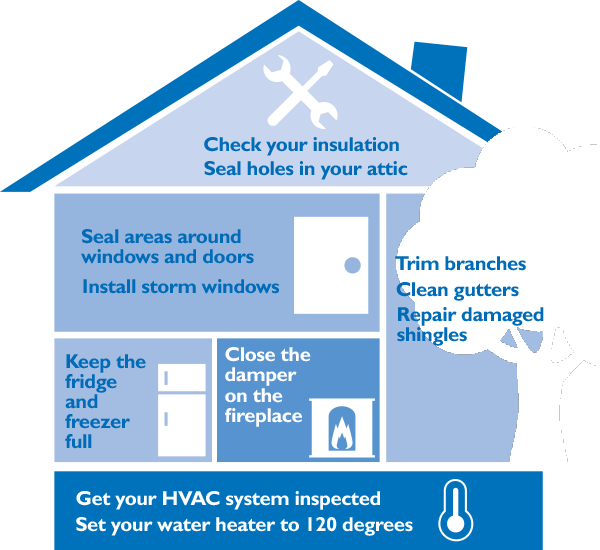It may not feel like winter yet, but the battle for your heating bills begins right now. Here’s a top-to-bottom checklist to get your home ready.

Outside the house
- Repair damaged shingles.
- Inspect your gutters. If they’re filled with leaves, that can lead to winter damage to your home’s siding and roofing, causing cracks and letting more cool air in.
- Cut down any extended branches that can get tangled with wires, causing power outages.
- Turn outdoor faucets off. Running or leaky faucets can cause pipes to freeze and explode. Flush outside faucets before winter to remove any excess water that could freeze later. Consider buying insulated covers for outdoor faucets.
The attic
- Insulating your attic can be the most cost-effective way to cut heating costs. Look across your attic floor. If the insulation is even with or below the attic floor joists, it’s time to add more.
- Seal holes in your attic. Weatherstrip and insulate the attic hatch or door to prevent warm air from escaping out the top of the house.
Inside the house
- In the kitchen, try baking multiple dishes at once to save time on using the oven. As you cook, keep pots and pans covered with lids to reduce cooking time.
- The cold months are the perfect time to put your crockpot and microwave to use, as both use less energy.
- Keep your refrigerator and freezer filled. By keeping your fridge full, you actually help prevent warm air from entering each time the door opens and closes. If you don’t have (or don’t want) a lot of food taking up room, fill some milk jugs with water and place them in the fridge.
- Make sure your fireplace is inspected and cleaned before you use it in the winter. When you’re not using your fireplace, make sure the damper is closed to prevent warm air (and your heating dollars) from escaping.
- In the winter, run the fan clockwise (from your position, looking up at it) to pull warm air down from the ceiling and keep it circulating in your house. There should be a switch on the fan to reverse its direction.
- Make sure heating vents are open and not blocked by furniture or carpet. Clean dust from vents or along baseboard heaters.
Windows and doors
- Inspect windows and doors. Repair decaying window frames, and cracked or broken glass. Install storm windows and doors.
- Weather-strip doors and caulk windows. A door guard or sweep can help fill the gap at the bottom of your front and back doors. You can find most of these items at local hardware stores.
The basement
- Have a certified heating, ventilation and air conditioning (HVAC) contractor inspect your furnace. If your furnace is 15 years or older, you may want to consider upgrading to a newer system.
- A new filter helps your HVAC system operate at its best and last longer. You should change your filter as often as every three weeks to as little as every six months. This depends on various factors, like how often you actually use your system to what kind of unit you have. If you have pets or allergies, you may need to clean and replace your filters more often.
- Set your water heater to 120 degrees (warm setting). Cover it with an insulated blanket you can purchase at a hardware store.

